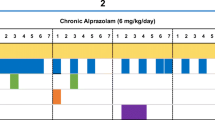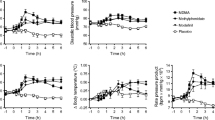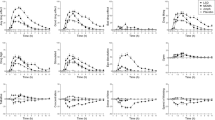Abstract
To examine whether or not prolonged exposure to a depot neuroleptic has either residual or “tardive pathological” effects onnormal behavior, 38Cebus apella monkeys were observed daily for 108 weeks. The issue of stress influencing such effects was also addressed. During weeks 25–48 half of the monkeys received 0.22 mg/kg fluphenazine decanoate, IM, every 3 weeks, with the dose increased to 0.33 mg/kg during weeks 49–72. Behavioral measures were combined to form composite behavioral variables which quantify four major aspects of behavior: self- and environment-directed behavior, affiliation, aggression, and normal locomotor activity. Mean plasma fluphenazine levels at 48 h post-injection were 0.13 (±0.03) ng/ml for injections 3–8 and 0.24 (±0.07) ng/ml for injections 11–16. The pre-study null hypothesis that the four major aspects of behavior would not be adversely affected by this treatment during the drug-discontinuation phase of the study (weeks 73–108) wasnot statistically negated. There were highly significant decreases in self-and environment-directed behaviors and affiliation during the treatment periods, implying that treatment may contribute to the negative symptoms of treated schizophrenics. Stress reduced the above effects. Aggression showed some increase during early drug discontinuation, accentuated by stress. Recovery of normal (baseline) behavioral scores began by week 7 after the last treatment. Mild (bucco-lingual) tardive dyskinesias persisted in 30% of the animals for a prolonged time.
Similar content being viewed by others
References
Barany S, Ingvast A, Gunne LM (1979) Development of acute dystonia and tardive dyskinesia in cebus monkeys. Res Commun Chem Pathol Pharmacol 25[2]:269–279
Casey DE (1984) Tardive dyskinesia — animal models. Psychopharmacol Bull 20[3]:376–379
Casey DE, Chase TN, Christensen AV, Gerlach J (eds) (1985) Dyskinesia — research and treatment. Psychopharmacology Suppl 2. Springer, Berlin Heidelberg New York
Chouinard G, Jones RT (1980) Neuroleptic-induced supersensitivity psychosis: clinical and pharmacological characteristics. Am J Psychiatry 136:16–21
Coffin VL, Latranyi MB, Chipkin RE (1989) Acute extrapyramidal syndrome in cebus monkeys: development mediated by dopamine D2 but not D1 receptors. J Pharmacol Exp Thera 249[3]:769–774
Dixon WJ (ed) (1988) Univariate and multivariate analysis of variance and covariance, including repeated measures. In: BMDP statistical software manual, vol 2. University of California Press, Berkeley Los Angeles London, pp 1045–1080
Domino EF (1985) Induction of tardive dyskinesia inCebus apella andMacaca speciosa monkeys: a review. In: Casey DE, Chase TN, Christensen AV, Gerlach J (eds) Dyskinesia — research and treatment. Psychopharmacology Suppl 2. Springer, Berlin Heidelberg New York, pp 217–223
Fleiss JC (1981) Statistical methods for rates and proportions, 2nd edn. Wiley, New York, pp 212–236
Freese CH, Oppenheimer JR (1981) The capuchin monkeys, genusCebus. In: Coimbro-Filho AF, Mittermeier, RA (eds) Ecology and behavior of neotropical primates, vol 1. Academic Brasileira de Ciencas, Rio de Janeiro, pp 331–390
Gualtieri CT, Quade D, Hicks RE, Mayo JP, Schroeder SR (1984) Tardive dyskinesia and other clinical consequences of neuroleptic treatment in children and adolescents. Am J Psychiatry 141:20–23
Gunne LM, Haggstrom JE (1985) Experimental tardive dyskinesia. J Clin Psychiatry 46[4]:48–50
Izawa K (1980) Social behavior of the wild black-capped capuchin(Cebus apella). Primates 21[4]:443–467
Jann MW, Greshevsky L, Saklad SR (1985) Clinical pharmacokinetics of the depo antipsychotics. Clin Pharmacokinet 10:315–333
Janson C (1985) Aggressive competition and individual food consumption in wild brown capuchin monkeys(Cebus apella). Behav Ecol Sociobiol 18:125–138
Kane JM, Smith JM (1982) Tardive dyskinesia, prevalence and risk factors, 1959 to 1979. Arch Gen Psychiatry 39:473–481
Lifshitz K, O'Keeffe RT, Lee KL, Avery J (1984/85) KIBOS: a microcomputerized system for the continuous collection and analysis of behavioral data. Appl Anim Behav Sci 13:203–218
Lifshitz K, O'Keeffe RT, Lee KL (1987) Cebus monkey behavioral interactions with fluphenazine decanoate,d-amphetamine and environmental stress. Psychopharmacol Bull 23[3]:487–492
Lo ES, Fein M, Suckow RF, Cooper T (1988) A highly sensitive and specific radioimmunoassay for human prolactin for quantitation of plasma fluphenazine. J Pharm Sci 77:555–558
McKinney WT, Moran EC, Kraemer GW, Prange AJ (1980) Long-term chlorpromazine in rhesus monkeys: production of dyskinesias and changes in social behavior. Psychopharmacology 72:35–39
Miller RE, Levine JM, Mirsky A (1973) Effects of psychoactive drugs on nonverbal communication and group social behavior of monkeys. J Pers Soc Psychol 28[3]:398–405
Neale R, Gerhardt S, Fallon S, Liebman JM (1982) Progressive changes in the acute dyskinetic syndrome as a function of repeated elicitation in squirrel monkeys. Psychopharmacology 77:223–228
O'Keeffe RT, Lifshitz K (1985) A behavioral profile for stumptail macaques(Macaca arctoides). Primates 26[2]:143–160
O'Keeffe RT, Lifshitz K (1989) Nonhuman primates in neurotoxicity screening and neurobehavioral studies. J Am Coll Toxicol 8[1]:127–140
O'Keeffe RT, Lifshitz K, Linn G (1982/83) Relationships among dominance, interanimal spatial proximity and affiliative social behavior in stumptail macaques(Macaca arctoides). Appl Anim Ethol 9:331–339
Richardson MA, Pass R, Craig TJ, Vickers E (1984) Factors influencing the prevalence and severity of tardive dyskinesia. Psychopharmacol Bull 20[1]:33–38
Rupniak NMJ, Jenner P, Marsden CD (1986) Acute dystonia induced by neuroleptic drugs. Psychopharmacology 88:403–419
Steiner W, Laporta M, Chouinard G (1990). Neuroleptic-induced supersensitivity Psychosis in patients with bipolar affective disorder. Acta Psychiatr Scand 81:437–440
Terborgh J (1983) Five new world primates — A study in comparative ecology. Princeton University Press, Princeton, pp 40–58
Visalberghi E (1988) Responsiveness to objects in two social groups of tufted capuchin monkeys(Cebus apella). Am J Primatol 15:349–360
Welker C, Becker P, Höhmann H, Schäfer-Witt C (1987) Social relations in groups of the black-capped capuchinCebus apella in captivity. Folia Primatol 49:33–47
Wiles DH, McCreadie RG, Whitehead A (1990) Pharmacokinetics of haloperidol and fluphenazine decanoate in chronic schizophrenia. Psychopharmacology 101:274–281
Author information
Authors and Affiliations
Rights and permissions
About this article
Cite this article
Lifshitz, K., O'Keeffe, R.T., Lee, K.L. et al. Effect of extended depot fluphenazine treatment and withdrawal on social and other behaviors ofCebus apella monkeys. Psychopharmacology 105, 492–500 (1991). https://doi.org/10.1007/BF02244369
Received:
Revised:
Issue Date:
DOI: https://doi.org/10.1007/BF02244369




